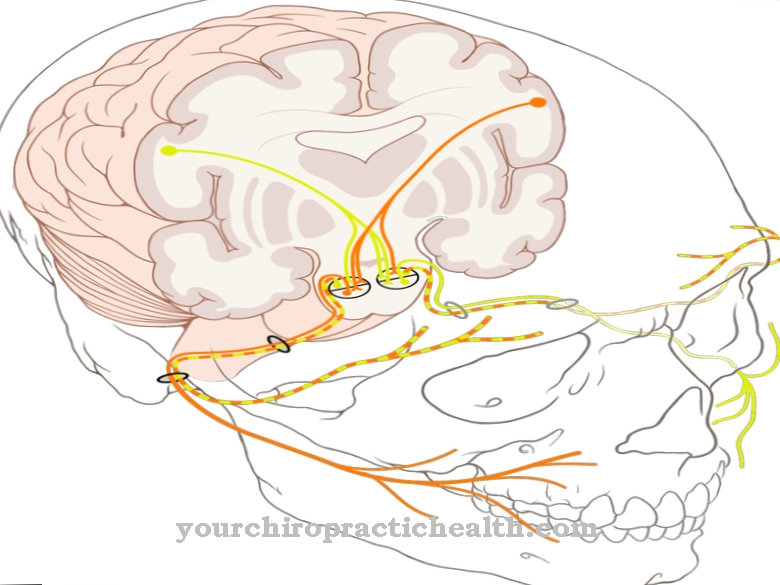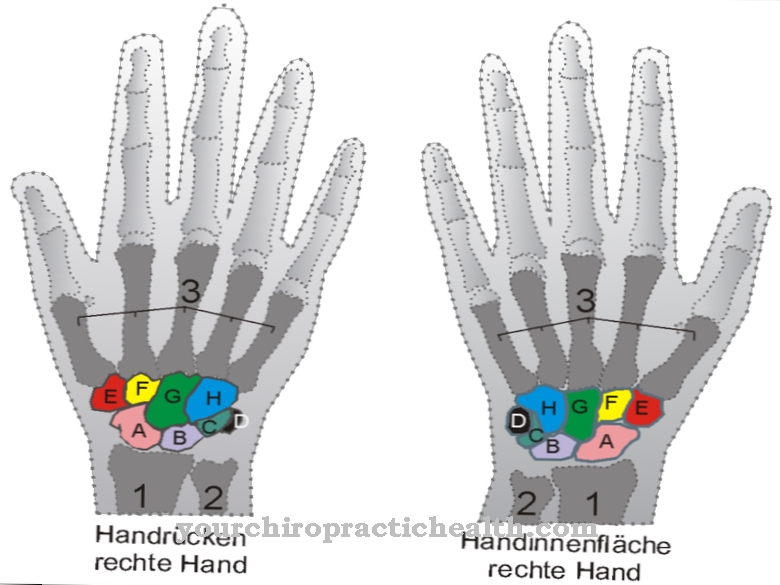The white matter can be understood as the counterpart of the gray cells in the brain. It consists of conduction pathways (nerve fibers), the white color of which is due to their medullary structure.
The white matter is part of the central nervous system and is also called Substantia alba respectively mark or Medullary substance designated. In the spinal cord it is next to the gray matter. There it is divided into a front, side and back strand. In the brain, the white nerve fibers are located in the inner regions and are surrounded by gray matter. The myelinated pathways, i.e. myelinated extensions of nerve cells, also show accumulations of gray nerve cell bodies. These are the so-called core areas in the spinal cord and brain.
What is the white matter?
The myelin sheaths responsible for the white coloration of the substance are formed by so-called glial cells in the central nervous system. These also belong to the white matter. On the other hand, the bodies of the nerve cells are as good as not in this area, apart from the development before birth.
Mainly on the surface, the white matter lies in the areas of the spinal cord and brain stem. Nerve fibers from a coinciding starting point and with the same destination are grouped into bundles, strands or tracts. In the cerebrum, the white matter is located in the central area and is also arranged in strands. The course of the nerve cords continues over the brain stem area and the so-called cerebellar stalks into the medulla of the cerebellum.
Anatomy & structure
The volume of the white matter fills almost half of the human brain. Overall, it can be imagined as a complicated system of several million connecting cables. Each of these strands has a branch of nerve cells that recognizes, forwards and transmits signals. Science speaks of an axon.
It is usually wrapped in the fatty myelin, which makes the substance white. The bundles, strands and pathways of the nerves divide again and under certain circumstances reconnect so that brain areas that are far apart can be linked. Thus, the white matter is very important for all processes in the brain that are related to learning. If the nerve cords show disturbances, this can have an extremely negative effect on the mental performance of the person. The imaging methods possible today can make the white matter clearly visible and refer to its causal effect with regard to possible mental and psychological disorders.
They also show the influence of white matter on intelligence and thinking skills. This proves that the nerve fibers determine the flow of information between the individual brain areas to a much greater extent than expected. An active brain, challenged to be active, may increase its white matter. When a person learns something new or, for example, acquires many new skills on a musical instrument, the white mass of the brain increases quantitatively. So it is trainable, which was originally thought impossible. On the other hand, it also becomes clear to what extent the white matter contributes to the decline in versatile thinking skills in old age.
Function & tasks
Over the past few years, new knowledge has also been gained about myelin, the fatty, whitish coat around the ducts. Initially it was assumed that this so-called medullary sheath was used solely to isolate the nerve fibers. Later, however, the question arose why some fibers then have no sheathing, while others have a thin or thick one.
For a long time it was also not entirely possible to explain why the myelin sheath has microscopic gaps (Ranvier tying rings) at a millimeter distance. It has now become clear that the nerve impulses on a wrapped (myelinated) conduction path advance about a hundred times faster than on an exposed one. Thanks to the "insulating tape", the electrical signals hop over the lace rings, so to speak. This is noticeable both in the central nervous system and in the various extremities.
You can find your medication here
➔ Medicines for relaxation & nerve strengtheningDiseases
The lifelong development of white matter in humans is characterized by ups and downs. In childhood and adolescence, their volume increases relatively evenly. It increases until the age of 40 to 50. But then the white matter is more or less slowly reduced again.
Accordingly, the mental performance gradually decreases. The flow of information between the individual brain regions comes to a standstill because the number of nerve fibers coated with myelin decreases. There is research that shows that the total length of myelinated fibers in a person is around 149,000 kilometers by the age of 20, but then decreases to around 82,000 kilometers by the age of 80. However, this does not necessarily mean that older people lose their acquired knowledge. It usually stays in good condition well into old age. The brain has the ability to compensate for certain deficits by itself.
A meaningful experiment with younger and older subjects showed that the responses in the motor area slow down with age. However, the researchers suspected that the brain's strategy behind this increased reaction threshold was to avoid hasty and thus possibly incorrect reactions. In fact, the older test subjects reacted more slowly than the young ones, but also had a lower error rate. It was also found that older people, despite their white matter deficits, are better able to activate certain areas of the brain compared to younger people.



























